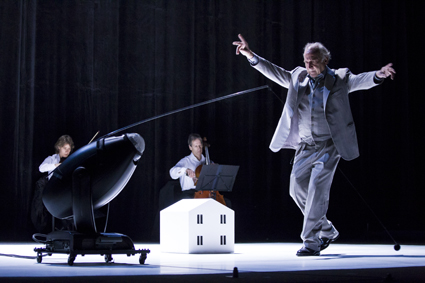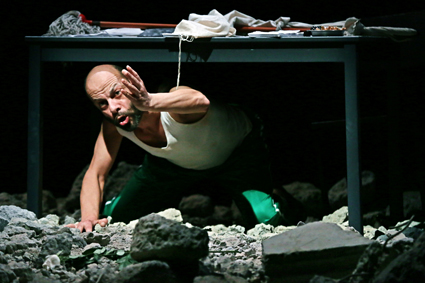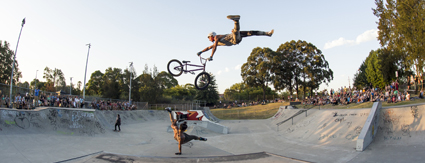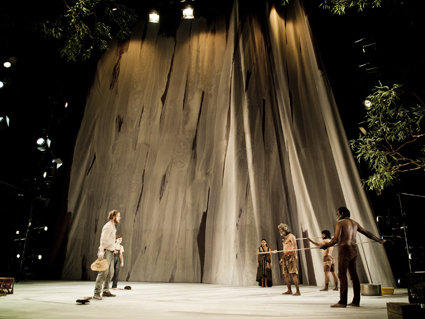degrees of subjectivity & the power of empathy
keith gallasch: 2013 sydney festival

André Wilms, Eraritjaritjaka—Museum of Phrases, Heiner Goebbels
photo Jamie Williams
André Wilms, Eraritjaritjaka—Museum of Phrases, Heiner Goebbels
INTERNATIONAL ARTS FESTIVALS SET HIGH EXPECTATIONS—AUDIENCES WANT THE BEST, WORKS WE WOULD NEVER NORMALLY SEE AND WHICH WILL CHANGE US. IN AUSTRALIA THESE FESTIVALS HAVE BECOME INCREASINGLY AMORPHOUS, VAST AND VARIABLE IN QUALITY.
The 2013 Sydney Festival produced a few works in the 16 I saw of the kind that embed themselves in the psyche, but I was more impressed by the ever increasing diversity of practices that now constitute performance and have gradually found their way into international festivals. But save for a predictable festival choice, The Peony Pavillion, where was Asia in this the Asian Century?
Heiner Goebbels’ Eraritjaritjaka was thought provoking and, equivalently, perceptually disorienting, while Semele Walk (see p14) proved to be fabulous entertainment effectively built on a wittily apt conceit. Branch Nebula’s Concrete and Bones Sessions, played out in a suburban skate park at twilight, magically deployed public space and popular skills to superb effect. Sabab Theatre’s In the Eruptive Mode, Voices from the Hijacked Spring revealed great potential, testing and extending our empathy with its subjective accounts of lives in a troubled Arab world.
heiner goebbels, eraritjaritjaka
Eraritjaritjaka is an elaborate music theatre meditation built on collected aphoristic utterances from writer Elias Canetti (delivered by a senior actor, the wonderful André Wilms, featured in the Kaurismaki film Le Havre), 20th/21st century string quartets (performed by the brave instrumentalists of Mondriaan Quartett who have to frequently re-form around the stage), and a house. The house is successively: a tiny model, its chimney smoking, a huge upstage cut-out which serves as a screen for projecting the actor’s taxi ride home mid-performance (to an East Sydney apartment where he chops onions to Ravel’s pizzicato) and, to our bewilderment, a huge onstage interior behind the cut-out, in which the actor, quartet and cameraman are glimpsed, the smell of cooking leaking into the auditorium. We’re astonished.
The quartet thunders, resonant with our surprise. When did the actual become virtual, and vice versa? To what degree can we trust our senses and, not least, our memory? How can we have any sense of self in a society dominated by surveillance (the camerawork constantly reinforces this), by those in power (musings on the orchestral conductor “relying on the immobility of the audience”), by speed (“look for someone to make you go slow”) and anxieties about the emergence of machine creatures. The man rather cruelly attempts to train a stumpy, two-wheeled robot with an antenna as if it’s a pet (“Do animals have less fear because they lack words?”). The robot however has a darker function, surveillance: it casts a harsh spotlight on the man, and on us (“secrecy is power”). Beyond these concerns about a society in which “each man prays to his own portrait,” the man/Canetti/Goebbels wonders about music: he “wants a new music with new dangers,” but “words swim with music; I mistrust the flowing.” However, not only is he persistently anxious about control, but also about the capacity to express emotion: “I have no sounds that could serve to soothe me, no violoncello like him [indicating the cellist]…no lament that anyone would recognize as a lament because it sounds subdued.” “I have no sounds of mine to soothe.” Eraritjaritjaka is an utterly enveloping reverie, beautiful and bewildering, and performed with verve, agility and passion by André Wilms; indeed his/Canetti’s/Goebbel’s words, entwined with music and words do soothe. (You can read the text of Eraritjaritjaka at www.heinergoebbels.com.)
in the eruptive mode

Raymond Hosni, In the Eruptive Mode, Sabab Theatre
photo Prudence Upton
Raymond Hosni, In the Eruptive Mode, Sabab Theatre
A work with much apparent promise, In the Eruptive Mode, written and directed by Sulayman Al Bassam, is a series of monologues reflecting on traumatic scenarios from the Middle East and beyond performed in English by visiting actors Raymond Hosni and Hala Omran, from Sabab Theatre (Kuwait/UK), and local Kym Vercoe. For the most part the monologues are deftly written and poetic, unfolding so that their implications effectively dawn on us. If at times accents make it difficult to decipher precisely what Hosni and Omran are saying, overall intentions can be grasped if not fully appreciated. Consequently I can’t altogether vouch for my account of the monologues.
A woman (Vercoe) in a flak jacket, face down on a table on a bed of rubble beneath harsh fluorescent light, muses over a lost pen, regards her hand as “a beautiful claw,” her eyes as fetching, but also as witnesses, her tongue “loose’ and “mawkish,” and wonders where her Kosovo cameraman is. She’s a journalist, perhaps wounded, certainly traumatised, attempting to pull herself together in the face of death—of the cameraman, of unnamed babies. Although near immobilised, Vercoe delivers a painfully incisive performance of a mind awaking from a delirium of too much pain, too much information.
A man slips out of lingerie and carefully attires himself in heavy traditional male clothing, covering himself almost entirely while speaking calmly of using “three to five vaginas a week” and noting the increased incidences of rape in the city. At the end he is an image of utter self-control and hatred of women and, implicitly, Western sexual freedoms. This is a chilling monologue, simple, but rooted in a powerful image of negative transformation. The third and much more complex monologue concerns a female doctor (Omran) whose male colleague “gets involved” politically with his patients, has to flee and is killed by a sniper at the border. Dying, he asks that his poems be sent to her. She reads them. Now she, like him, becomes “involved.” The writing is dense, the character detached, believing she is above ‘involvement,’ but the outcome is moving in a finely tuned performance. In total contrast, a man in a village or perhaps on a farm waves a white flag, praying that rebel forces will leave his family alone. Not only has he had to pragmatically swap sides but has already sacrificed his “demented,” dissident daughter, whom he cannot forgive. He is doomed; a simple man in a complex trap, convincingly portrayed by Hosni.
The least successful piece has an over-the-top, suited saleswoman (Vercoe) hard sell us a security plan for wealthy ‘investors.’ Low on effective irony this monologue is at a far remove from the others, where individuals live out their pain and dilemmas, including the final piece (where accent and sound system failure diminished intelligibility) in which a 28-year old woman surrounded by gunfire combs her hair, sings, polishes her gun and reflects on her love for her father. In an Eruptive Mood might be modest in scale and somewhat under developed, but its vision of psychological distress and trauma in a region in crisis is writ memorably large.
concrete and bone sessions

Concrete and Bone Sessions, Branch Nebula
photo Jamie Williams
Concrete and Bone Sessions, Branch Nebula
A suburban skate park, massive freight trains rumbling by, the sun breaking through gold-rimmed, rain-threatening clouds, wind through the trees—a stunning setting for Branch Nebula’s Concrete and Bone Sessions. The concrete is, of course, the skate park, the bones those of bold skaters, BMX-ers and dancers. This is site-specificity of the most immediate kind, a visceral connection to a place of play, not its social role or its history, in a display of what is often regarded as fun but here as art without losing the integrity of its popular foundations. The outcome is a visual spectacle, impeccably choreographed so that star turns are embedded in and shoot out of the mesmeric poetry of the grand sweeping collective rides and runs that transform the concrete into a magic, enabling vessel. Amplifying the action is a dynamic sound score, heavily percussive, dramatic, romantic and extended by performers wearing belt speakers, weaving sounds across the resonant concrete bowl. As for lighting, there was none, the magic of twilight and the weather was more than enough, a reminder of the everydayness of a suburban skate park and a celebration of its potential.
The power of Concrete and Bone Sessions comes from its lyricism, carefully paced, ever evolving, building towards escalating teamwork, spectacle and risk-taking but without turning into a series of stand-alone acts. The interplay between those on their feet and those on wheels escalates, as does the working of all dimensions of the park—edges to pivot on, walls to slide down, fences on which to elegantly parkour. Not least, thanks to the duration and pacing of the work, discrete personalities and styles emerge—degrees of reserve and flamboyance, but always within the work’s framework and pulse. There were many moments of magic, not least a freight train driver signalling his approval, the train’s horn blast and the rumble and screech of wheels merging into the show’s sound mix as BMX-ers flew high. Concrete and Bones Sessions was a festival highlight, a very special work, exhilaratingly focused on the beauty of collective movement and daredevilry. (See realtime tv video interview with Branch Nebula about the preparations.)
the secret river

The Secret River, Sydney Theatre Company
photo Cassandra Hannagan/ABC Arts online
The Secret River, Sydney Theatre Company
STC’s The Secret River was not a favourite (I’m apparently alone in this, such has been the critical acclaim for the production) although I admired the performances, thought Stephen Curtis’ vast design superb (a massive wall of bark flowing from high, down into a wide stage cloth) and admired the largely faithful, economical reduction of Kate Grenville’s novel to a manageable two hours or so of stage time. The production also opened out stage time to allow a degree of focus on the Indigenous figures, making them strong if still secondary presences.
The strength of Grenville’s novel lies in the subjectivity it affords its principal character, the former convict William Thornhill. It’s a rich responsiveness to his condition and especially to the land he claims along the Hawkesbury. But it’s not something he can voice, because much of it is felt and intuited. In the dominant tradition of third person novel writing, the novelist’s voice goes unmarked but details for us nuanced thoughts, sensual feelings and emotional tensions as if coming from their subject. What goes on in Thornhill’s head, and to a degree other characters, is what makes this conventional novel a rewarding experience. We can intimately witness how Thornhill grows to love an alien land, senses the rights and wrongs of taking it for himself, understanding in some way that it belongs to someone else, and resists the urge to over-react to the Aboriginal presence—until things get out of hand. Much of this goes missing in the stage adaptation. Nathaniel Dean’s gruff but sensitive performance conveys some of the tensions, but not much more than the script allows. To compensate, adaptor Andrew Bovell has invented a narrator (Ursula Yovich), a young Aboriginal woman in 19th century dress who tells us a little of what Thornhill is thinking and feeling, but barely enough. At other times, the narration appears unnecessary.
Why have an Aboriginal narrator (hardly blind casting in a work of this kind) telling us what a white man thinks and feels in a story focused on his ambition, his pain and his success? Complicating the narrator’s role is her appearance as a character, curing Thornhill’s ill wife in a quasi-ritualistic moment of great emotion. In the novel a white woman provides the cure without ceremony. Perhaps research or a cast member recollection from family history provided this scene, or it’s simply a Bovell invention. Whatever it’s origins, it felt calculatedly melodramatic.
Could The Secret River have done without a narrator—a role that might be read as tokenistic by an Aboriginal audience? By Act II I was hungry for a monologue even—anything to give us something more of Thornhill than revealed through his blunt dialogue. Much will be written about The Secret River. Already several reviewers have declared its candidacy for ‘Australian classic.’ But I felt a palpable distance between myself and Thornhill, despite a strong performance. Of course, the novel form allows for considerable evocation of interiority, but many a play has done as well or better.
Indigenous writer Kim Scott’s award-winning novel That Dead Man Dance (2010), also set in the early 19th century, is another powerful evocation of subjectivity and first contact, this time from an Aboriginal point of view—unnervingly realigning our culturally informed sense of movement and space. A dramatized version could provide a welcome counterbalance to The Secret River. Doubtless The Secret River will become a national success, but whether or not it can contribute seriously to the “textual healing” some have claimed for it is another matter.
more sydney festival
In brief, I enjoyed the rich vein of inventiveness and humour that flowed through Belvoir’s Peter Pan and STC/Windmill’s School Dance; found that the melancholy reverie about deceased parents that is Conch Theatre’s MASI told us too little about them; thought Raimund Hogue’s Sacre—The Rite of Spring, had dated badly since offering such a strong conceptual challenge to dance in the early 2000s; wondered whether or not the adroitly performed The Moment I Saw You I Knew I Could Love You, by curious, added up to a cogent artistic statement; admired the dextrous puppetry of It’s Dark Outside, if uncertain of the efficacy of the work’s structure; revelled in the acoustic works in Ensemble Offspring’s Ligeti Morphed; and admired Camille’s delivery of Shakespeare’s verse in The Royal Shakespeare Company’s The Rape of Lucrece—but was appalled by the banality of the songs and the performer’s overacting. Erth’s Murder had an abundance of talent and promise but, after a strong start where it connected with its inspiration, the Nick Cave album Murder Ballads, it drifted away into its own complicated narrative albeit with flashes of inspiration and a strong central performance. And I heard very good things about Othello C’est Qui from Germany in the About an Hour series at Carriageworks, but festival timetable congestion prevented me from seeing it.
Sydney Festival 2013: Eraritjaritjaka—Museum of Phrases, words by Elias Canetti, performers André Wilms, Mondriaan Quartett, composed & directed by Heiner Goebbels, stage design and light: Klaus Grünberg, live video Bruno Deville, Theatre Royal, Jan 5-27; Sabab Theatre, In the Eruptive Mood, writer, director Sulayman Al Bassam, performers Raymond Hosni, Hala Omram, Kym Vercoe, design Sam Collins, lighting Marcus Doshi, music Lewis Gibson, Seymour Centre, Jan 8-11; Branch Nebula, Concrete and Bone Sessions, creators Lee Wilson, Mirabelle Wouters, performers/collaborators Jared Graham (Leerok), Antek Marciniec, Kat Williams, Marnie Palomares, Danny Campbell, Kathryn Pule, Michael Steingraber, Roland Chiouk, Cloe Fournier, Daniel Sparrow, sound/composer Bob Scott, dramaturg John Baylis, musicians Inga Liljestrom, Bree Van Reyk, Timothy Constable, Hugh Coffey, Jack Shanahan Reserve, Dulwich Hill, Jan 9-19; Sydney Theatre Company, Secret River, adapted from the novel by Kate Grenville by Andrew Bovell, director Neil Armfield, artistic associate Stephen Page, performers Nathaniel Dean, Bailey Doomadgee, Lachlan Elliott, Kamil Ellis, Roy Gordon, Iain Grandage, Ethel-Anne Gundy, Anita Hegh, Daniel Henshall, Trevor Jamieson, Judith McGrath, Callum McManis, Colin Moody, Rhimi Johnson Page, Rory Potter, Jeremy Sims, James Slee, Bruce Spence, Matthew Sunderland, Miranda Tapsell, Tom Usher, Ursula Yovich, set designer Stephen Curtis, costumes Tess Schofield, lighting Mark Howett, composer, musician Iain Grandage, sound designer, dramaturg Matthew Whittet, Sydney Theatre, Jan 12-Feb 9
RealTime issue #113 Feb-March 2013 pg.






